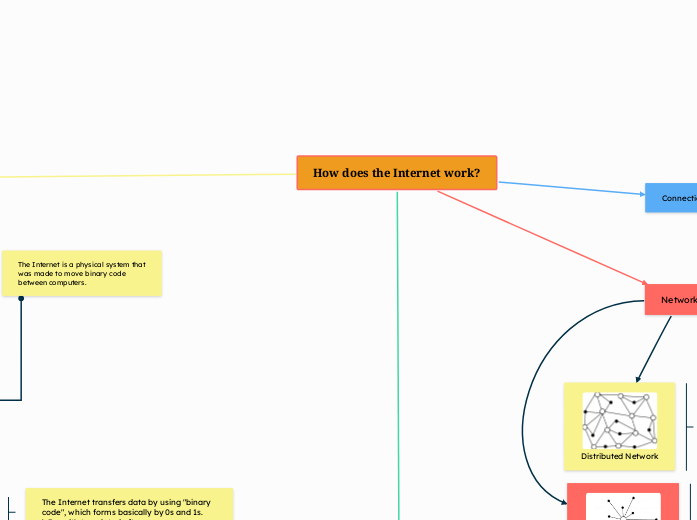How does the Internet work?
Networks
Connections
Infrastructure
Protocols
In order to connect to the global network, you first need to get access to it through an Internet Service Provider (ISP).
To describe the number of bits we can send in a fixed amount of time, we
use bandwidth.
Packets are sent along the Internet.
A router is a type of computer that forwards data across a network path, towards the IP
address of the intended receiver.
The Internet is a global network of billions of
computers and other electronic devices.
A computer network is a group of interconnected computing devices
capable of sending or receiving data. A computer network is a type of
computing system.
End to end connectivity is a principle that anyone can connect to the Internet
and communicate with anyone else on another "end" at any time.
The electrical signals can travel over
different types of transmission mediums
throughout its journey, including:
Copper Cables
Optical Fibers
Wireless
Packets
Physical Infrastructure
Packets might arrive out of order but arrive to the right reciever.
(Transmission Control Protocol/Internet Protocol): These are the
main building blocks of the internet; they help computers find each other
and make sure data gets delivered correctly.
End to end connectivity
Computing device
Computing system
Packets are assembled again ready to be displayed
Latency is how long it takes data to travel between its source and
destination, measured in milliseconds (ms)
Bandwidth
Packets are pieces of binary information that have been formed from digital data. Which are used to send and receive pieces of information (texts, documents, images, videos, etc.
Packets contain the binary code for the data, the IP address of where it came from, and the IP address of where it is going.
3G,4G,5G
Satellite
Dial Up:
Cable:
The Internet is a physical system that
was made to move binary code
between computers.
Internet Moving Data
Computer network
Distributed Network
Data is broken down into packets.
Step 2:
Step 3:
Step 4:
A computing system is a group of computing devices and programs working
together for a common purpose.
If a part of this network goes down, the
devices can still be connected through
other device routes.
HTTP (Hypertext Transfer Protocol): This is the protocol for your web
pages; it's how your computer asks a web server to send a webpage so you
can see it in your browser.
SMTP (Simple Mail Transfer Protocol): This is the protocol for sending
emails; when you hit "send" on your email, SMTP makes sure it gets to the
right email server.
A computing device is a physical artifact that can run a program. Some examples include computers, tablets, servers, routers, and smart sensors.
Step 1:
Protocols are the official rules and sets of
procedures that computers follow to make
sure that other computers know how to read
and transmit the data being sent.
TCP/IP
HTTP
SMTP
ISP's
Centralized Network
TCP (transmission control protocol) breaks down the information you wish
to send into packets.
Those packets are then forwarded across the internet
Once they are received by the IP address they were sent to, their TCP
reassembles the packets in the correct order.
The Internet transfers data by using "binary code", which forms basically by 0s and 1s. Where it's translated after.
Latency
On the Internet, there is no central location of it. It is made up of billions of servers, routers, and networks. The internet follows rules (called protocols) that govern how computing devices that connect to the internet "talk” to each other.
